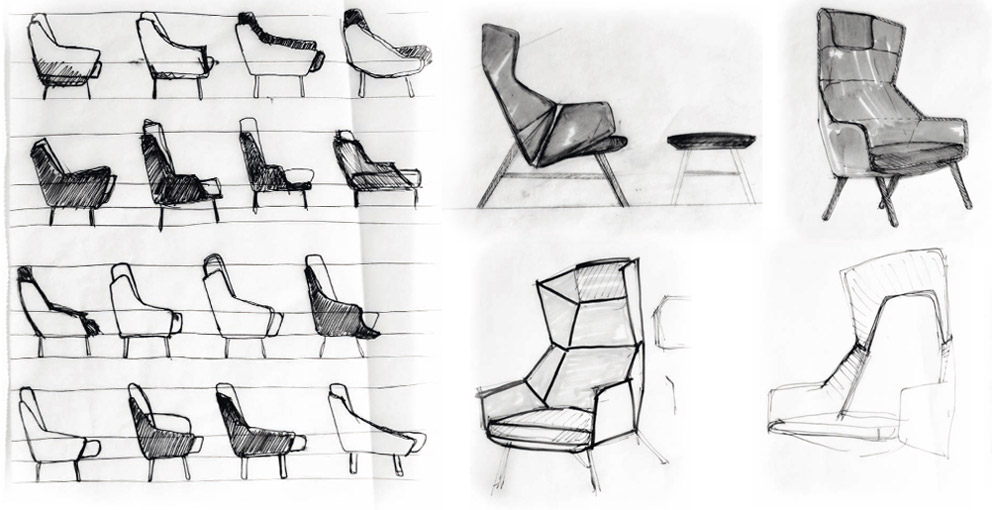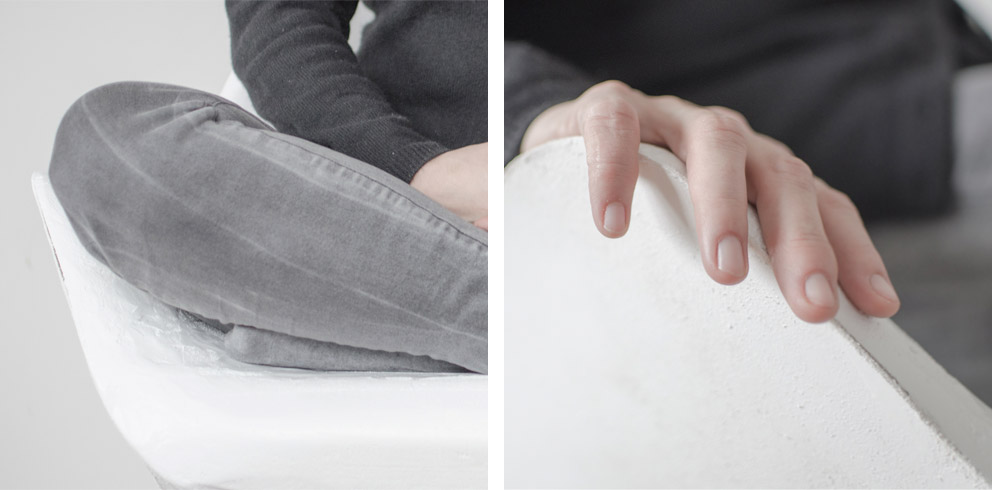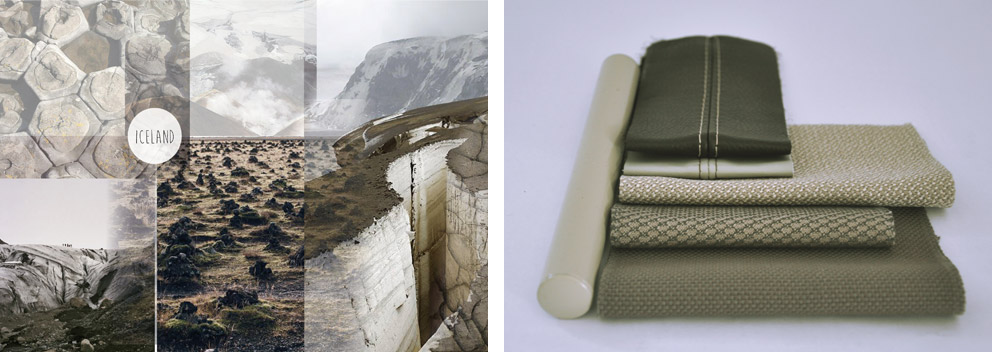Claudia Kleine und Jörg Kürschner alias „Formstelle“
| Feb 5, 2015
Thomas Wagner: You’ve not only designed a lounge chair for Thonet, you were also co-responsible for the entire development. How did the project come about and who initiated it?
Jörg Kürschner: We were already in contact with Thonet, had also visited Frankenberg, had toured the company, introduced ourselves to them, and presented the various things we had already done. And now we were given a real task.
So what was the task?
Jörg Kürschner: We were asked to think about a lounge chair that would be both comfortable and also set a clear mark.
Was the actual design of a lounge chair something you were already thinking about at that point? Had you thought about that type of chair before?
Jörg Kürschner: Since we were supposed to focus on a wing armchair, which was something we hadn’t done before, as opposed to a lounge chair, which we had, the topic was more or less new ground for us. Moreover, it was a real challenge to be able to work for a company such as Thonet. New company, new topic, what more could one want...
Claudia Kleine: A wing armchair is such an exciting topic because it is a type of furniture that takes up so much space. We therefore also closely concerned ourselves with the motivation and the context. How much does a person need to immerse herself, to feel at home, and yet to still remain open to what is going on around her? Does she want a wing armchair in order to be man alone and yet be able to take note of what is going on around her? Does she want a certain degree of comfort? If so, what sort of comfort? – Or: What is the function of a skin in architecture? What does skin mean in the items of clothing I wear? What protects me? What gives me the feeling I am protected? A collar perhaps? You see, we really went into the topic in great depth.

So what was the outcome of your discussion of “closed” and “open”? Where and how do you draw the line between being “sufficiently enclosed” and yet “open enough”?
Jörg Kürschner: Well, we worked on and with that line. First, analytically, and then using countless real models, toying and experimenting with that line. What comfort do you need to shield yourself, to be able to immerse yourself, to reach a contemplative state? What postures are possible in the armchair? How does it need to be built if it is to allow you to both sit still and be able to move?

So how did you come up with the solution?
Claudia Kleine: Above all using models. We built models, cut out sets of cardboard, held them up, and closely examined the different postures. Where do I want to rest my head? What do I do with my hands? Am I comfortable sitting cross-legged? – We built models for all of this, using foam, cardboard, and tape, adding bits, removing bits.
Jörg Kürschner: Once the initial ideas and sketches had spawned specific underlying conceptual motifs, more or less everything got decided using life-size scale models, and that even included a model with an improvised mechanism. We simply wanted to try out the different stages. And we also had people of different weights sit down on it. Meaning the shape and features were not the product of a drawing, but defined by ergonomic and empirical processes we undertook.

How did you come up with the idea of two shells?
Claudia Kleine: That happened when we resolved that it should be possible to adjust the tilt angle.
Jörg Kürschner: There was also a point where we experimented with a rocker mechanism. But that wasn’t good enough. We wanted to go for the max.
Claudia Kleine: A lot has to do with the postures we mentioned: Where is the head, the hands, where am I in contact with the backrest, where is the furniture, where exactly is the point of contact?
So you developed the armchair on the basis of the human body, the human postures and self-perception? Along the lines of: How does one feel in this small cell or sphere?
Claudia Kleine: All of that is reflected in many details, but also in the formal feel of the whole. On the outside there’s the clearly defined shell, and inside the pleasant upholstery. Many who see the armchair say spontaneously: hard outer shell, soft core. Meaning: What comfort do I enjoy when sitting in the armchair, and how much of that comfort can be discerned from the shape? Inside there’s the soft upholstery and cushion, outside a shell with clear contours – we felt very strongly that this contrast had to be legible.


You then developed the upholstery and even a complete system of fabrics and leather, not to mention multicolored combinations. Then there are three different base frames. How did all that come together?
Claudia Kleine: We thought that today clients specifically want to be able to customize such an armchair, precisely because such a comfy wing armchair snuggles up to you, is personal, is important to you. We therefore developed color systems and different material mixes, not to mention three frames which we think are pretty good and thus insist on. It is a complex range of options for individualizing the armchair.
Jörg Kürschner: Needless to say, the tubular steel base frame fits the Thonet lineage well. But there are new variants, too, such as the flat steel frame and the one made of bentwood. In other words, at the end of the day we managed to get back to bentwood, again taking up a renowned Thonet tradition.

What’s your favorite? Or aren’t you allowed to have one?
Both: (laughing) But of course we do, everyone does!!
So which frame?
Claudia Kleine: Definitely the wooden one!
Jörg Kürschner: I prefer the flat steel frame!
OK, then I’ll choose the tubular steel version.
(everyone laughs)

Claudia Kleine: As regards the fabric, we set out to subdivide the main upholstery areas accordingly. In a manner that could be perceived in three dimensions. Together with fabric makers Rohi we therefore designed an exclusive virgin-wool textile that has a multi-dimensional honeycomb structure, meaning depth and height.
Jörg Kürschner: Rohi’s “Soul” fabric is available in countless different color versions and in six different main colors – under, island, air, tropic, urban and grey. There’s leather, and the ornamental seams are calibrated to the respective combination. Many of these themes have something conceptual about them.

How did you address the technical details? After all, you developed a very special shell that paves the way, as it were, for design aspects such as the seams, etc.?
Jörg Kürschner: It was really great that we were able to work so closely with the Thonet development department on this. As only in this way were we able to look for new production methods and bring together people with quite different areas of expertise. The result is a quite unique layered structure with a purpose-developed mechanism, an inner life consisting of a die-cast plastic rotation piece to which special cushions are attached – and the outer cladding shells that are available in formfleece versions, but also with either leather or fabric covers. Which has given rise to a very complex structure.
Looking back, what was tough and what was especially exciting?
Claudia Kleine: The most exciting thing was being able to realize a holistic project, a project with an incredible number of different aspects to it. The complexity innate in this armchair is amazing. That’s the way we love to work. Simply submitting a design is less our thing. It’s simply much more fun and the results are far better if you can study a task from various angles, garner experience related to it, and draw your own conclusions. Although, given the tight schedule, it was a tall order in this case.

So how much time did you have?
Claudia Kleine: One year, including developing the fabric, the machine tools, etc.
So that’s what people today tend to associate with the term ‘design process’?
Claudia Kleine: Sure, precisely not just handing in a 3D rendering, but participating in all the development work, taking part in things, through to the small leather loop that you pull on to adjust the armchair – you can’t imagine how many models we made just for that little item...
Jörg Kürschner: Well it’s both a great honor to be able to work that way, but it also means shouldering a lot of responsibility.
One thing was for sure at the fair: There are suddenly all manner of lounge chairs again. How so? During your analytical study, did you come across reasons for such a revival? Or put differently: What is the need that leads to the wish for a contemporary wing armchair?
Claudia Kleine: I think it has to do with the need to be able to withdraw. The large interior worlds, the huge living room landscapes and lounges really cry out for spaces that constitute very personal seating.

So back to cocooning, but with a slight difference?
Claudia Kleine: Yes, whereby the need for places to retreat to has risen in particular in the contract world, more than in private homes. People want more home comforts in public zones. Which is something a piece of furniture such as a lounge chair embodies.
Jörg Kürschner: It is simply pleasant to be able to swiftly immerse yourself in your own sphere, to have a place that is both open and closed.
Meaning that in our often hectic world of permanent comms, the lounge chair is a relatively easy, mobile haven of privacy?
Jörg Kürschner: ... and a kind of instrument ...
Claudia Kleine: Humans first lived in caves, and probably that is why they want a wraparound skin that can be perceived as such.
What does it mean for you that many people today create such a skin using multimedia, earphones, music as the outer shield? Does that influence your work as designers?
Jörg Kürschner: More as an antipode, as a contrast to the furniture. If I’m lounging in such an armchair I precisely don’t need all the media to immerse myself in my world and simply contemplate things.
Claudia Kleine: We are both shaped far less by things digital and more by those analog. The aspect you mention is interesting, but was never really an issue for us. I don’t even own a TV.
And what are your next projects? Where is Formstelle now heading?
Claudia Kleine: The armchair for Thonet is called “Program 808”, meaning you can expect more. Which is what we’re working on right now.

So what is it all about?
Jörg Kürschner: Let’s just say that the product line may expand.
Claudia Kleine: We’ve just designed a new sofa for Zeitraum that is based on the Morph Lounge family, and we are busy working, again for Zeitraum – on an upholstered furniture system that will be presented in Milan.
Do you tend to turn to given conventions or typological aspects in order to reinterpret them? Is that an apt way of describing your approach?
Claudia Kleine: Definitely. We above all try to develop a product using a holistic methodology, meaning rethinking aspects from all sorts of different angles.
I didn’t expect you to be designing earphones going forward. But who knows? Above all young people use them nowadays to maintain privacy when in public.
Claudia Kleine: But young people are also so open, constantly communicating, twittering all the time.
But are not focusing on their immediate surroundings, and are instead connected to some huge remote thing that is physically a long way away. What does it mean to be here and also to be a long way off, as when skyping?
Jörg Kürschner: We are of course familiar with this kind of communication from our various projects, but when it comes to developing a piece of furniture then I tend to try and get away from what surrounds me, and opt more for a mixture of contemplation and concentration.

Would you agree if one were to say that we have not yet grasped all the consequences that the radical shifts in media bring with them?
Claudia Kleine: And that includes as regards our personalities. I want to be on my own and yet share my intimacy with others, meaning I have to decide when, how and where I abandon the boundaries of my space as a person.
Are such boundaries in general important for the Formstelle duo? How to find the right balance between opening up to the outside world and cutting oneself off?
Claudia Kleine: By exploring the boundaries, your own, those of the materials, and those of the technology. Which means: You have to go down a long path involving many discussions.
Jörg Kürschner: In purely technical terms and as regards the substantive aspects, on the Thonet project we were able to explore boundaries and did so in a pretty uncompromising way.
Do you test boundaries in other fields? Perhaps extreme sports?
Both: (laughing) No, design is enough for us.
Then thanks for taking the time for us.













